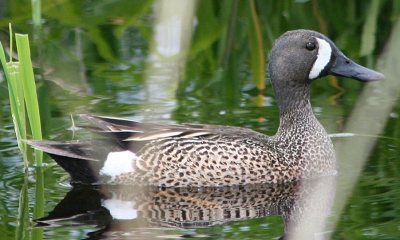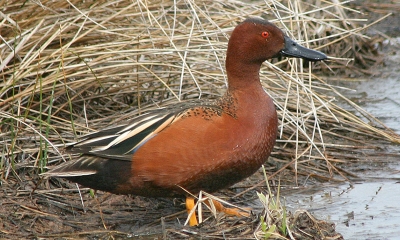
Teal
Teal are small puddle (dabbling) ducks that prefer shallow freshwater areas like marshes, ponds and some rivers. They typically feed on the surface on the water, and feed primarily on aquatic vegetation, seeds and grain. In flight, teal often stay in tight groups that may twist and turn as one unit.

Types of Teal

Features: Except for adult drakes in breeding plumage, blue-wings are difficult to distinguish from cinnamon teal. Adult blue-wing drakes have a gray head with white crescent between the eye and bill. Hens and young of both species are nondescript small brown ducks, but show the prominent blue wing-covert patch in flight.
Blue-winged teal is an early migrant and extremely rare winter resident in Oregon. Many hunters who believe they have shot a blue-winged teal actually have probably taken a hen or young drake cinnamon teal, both of which have identical wings with a large blue shoulder patch.

Features: Male cinnamon teal have a cinnamon-red head, neck, breast and belly. Like blue-winged teal, they have a bright patch of iridescent green on the rear of the wing and a bright blue patch on the front of the wing. They also have a distinctive red eye, a black bill and yellow legs and feet. Female and young male cinnamon teal are often confused with female blue-winged teal.
Habitat: Prefer shallow, alkaline lakes where they dabble on aquatic plans.
Techniques: Most cinnamon teal in Oregon are taken in eastern Oregon in the early season. They are not common enough to be targeted specifically, and are an occasional part of a mixed duck bag.

Features: In breeding plumage, green-winged drakes have a cinnamon-colored head with a green eye-stripe, gray back, flanks, and a bright patch of iridescent green on the rear of the wing (speculum). Hens are brown with a green speculum.
Habitat: Green-winged teal are primarily winter migrants in Oregon. They are puddle (dabbling) ducks that prefer shallow areas like ponds and marshes, where they feed on or near the surface of the water by tipping up.
Techniques: Teal are early migrants that begin arriving in Oregon in August but will continue to arrive into November. There are good early season hunts in coastal areas and Summer Lake, with hunting into the winter in western Oregon, the Columbia Basin and in the Ontario/Vale area.
Teal respond well to decoy spreads, and it’s not necessary to call. Although blowing a teal whistle can be a good activity for the kids hunting with you.
Green-winged teal can be fine eating.

